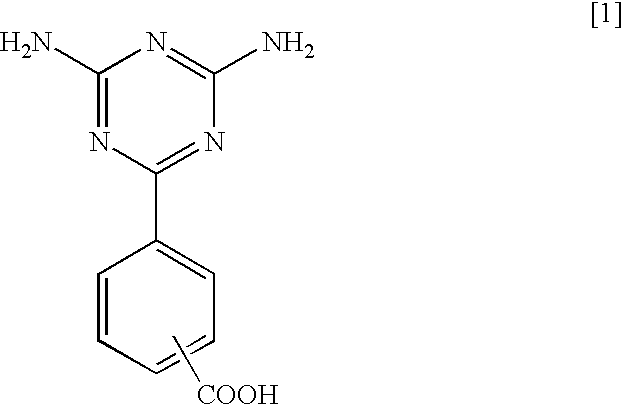Lithographic printing plate and image forming method
a technology of image forming and printing plate, which is applied in the field of lithographic printing plate, can solve the problems of low sensitivity, preservation stability and printing resistance, and the reproducibility of halftone dots
- Summary
- Abstract
- Description
- Claims
- Application Information
AI Technical Summary
Benefits of technology
Problems solved by technology
Method used
Image
Examples
synthesis example 1
(Synthesis Example of an Acrylic Resin)
In a 1L four-necked flask equipped with a stirrer, a condenser, a dry nitrogen introduction pipe with a thermometer, and a dripping apparatus was charged 400 g of methyl ethyl ketone and the temperature was elevated to 80.degree. C. A well mixed solution of 80 g of styrene, 253.44 g of methyl methacrylate, 51.32 g of acrylic acid, 15.24 g of butyl methacrylate, and 8 g of PERBUTYL-O (trade name for a polymerization initiator manufactured by Nippon Oil & Fats Co., Ltd.) was then dripped into this over 2 hours. After dripping, stirring was continued for an6 ther 15 hours, to thereby obtain an acrylic resin having a dry solids ratio of 49.5%, an acid value of 50.1, and a number average molecular weight of 18,000. Hereinafter, this acrylic resin is referred to as "acrylic resin (1)".
synthesis example 2
(Synthesis Example of an Acrylic Resin)
In a 1L four-necked flask equipped with a stirrer, a condenser, a dry nitrogen introduction pipe with a thermometer, and a dripping apparatus was charged 400 g of methyl ethyl ketone and the temperature was elevated to 80.degree. C. A well mixed solution of 80 g of styrene, 205.92 g of methyl methacrylate, 41.04 g of acrylic acid, 45.04 g of butyl acrylate, 28 g of 2-hydroxyethyl methacrylate and 8 g of PERBUTYL-O (trade name for a polymerization initiator manufactured by Nippon Oil & Fats Co., Ltd.) was then dripped into this over 2 hours. After dripping, sti rring was continued for another 15 hours, to thereby obtain an acrylic resin having a dry solids ratio of 49.8%, an acid value of 40.2, and a number average molecular weight of 21,000. Hereinafter, this acrylic resin is referred to as "acrylic resin (2)".
synthesis example 3
(Synthesis Example of Acrylic Resin Fine Particles) 100 g of a solution of the above-described acrylic resin (1) was neutralized with 26.7 g of aqueous solution of 1.0M sodium hydroxide, and water was dripped. The resin solution increased its viscosity slowly and when about 150 g of water was dripped, the viscosity decreased abruptly, which indicated that the phase inversion was completed. After further addition of 150 g of water, the resulting dispersion was heated to 30.degree. C. and the organic solvent and excess water were removed under reduced pressure to obtain a concentrate. Water was added to the concentrated resin solution to thereby adjust the dry solids ratio to 30%. Hereinafter, this is designated as water dispersion of acrylic resin fine particles (A). The average particle diameter thereof was 0.2 .mu.m.
PUM
 Login to View More
Login to View More Abstract
Description
Claims
Application Information
 Login to View More
Login to View More - R&D
- Intellectual Property
- Life Sciences
- Materials
- Tech Scout
- Unparalleled Data Quality
- Higher Quality Content
- 60% Fewer Hallucinations
Browse by: Latest US Patents, China's latest patents, Technical Efficacy Thesaurus, Application Domain, Technology Topic, Popular Technical Reports.
© 2025 PatSnap. All rights reserved.Legal|Privacy policy|Modern Slavery Act Transparency Statement|Sitemap|About US| Contact US: help@patsnap.com

